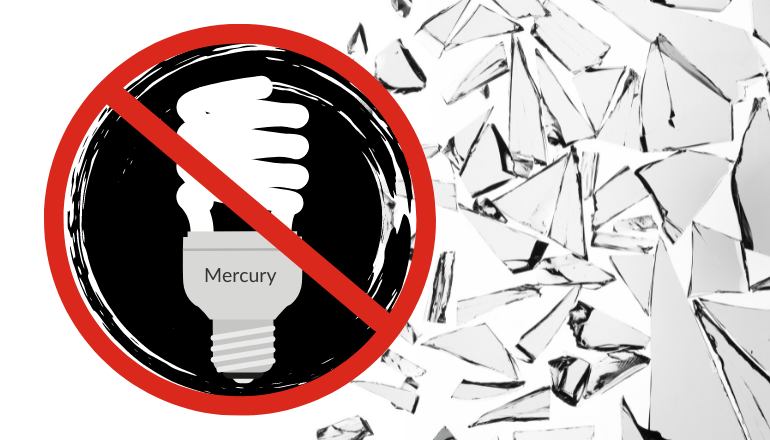Coalition Calls for Phase Out of Mercury in Lighting in Vermont
A new report released today by the Vermont Public Interest Research Group, the Mercury Policy Project and the Clean Lighting Coalition highlights the environmental and health risks posed when fluorescent lamps break, especially to vulnerable populations. The report provides concrete steps government, industry, consumers, and others, like childcare providers, can take to accelerate the transition to LED lighting, which is mercury-free, more energy-efficient, more cost-effective, and widely available.
“Vermont policymakers have long-recognized the threat to public health posed by mercury-containing products,” said Paul Burns, executive director of the Vermont Public Interest Research Group (VPIRG). “State law even provides a roadmap for eliminating mercury lamps once safer lighting becomes available. Well, thanks to LED lightbulbs that day is here, so it’s time to pull the plug on mercury lamps in Vermont.”
The report details:
- Health risks to those exposed to mercury, especially populations that are more vulnerable, such as pregnant people and their unborn babies, infants and young children, communities of color, and those living in low-income neighborhoods
- Health risks to workers exposed to mercury when lamps break during the manufacturing, installation, recycling, and disposal of fluorescent lamps
- Environmental hazards posed by the release of mercury in fluorescent lighting
- Benefits of transitioning to LED lighting, now considered the most cost-effective and reliable lighting option in the U.S. marketplace
“We know that mercury exposure, especially in early life, can lead to irreversible deficits in verbal skills, reduced attention span and motor control, and lower IQ,” said Michael T. Bender, director of the Vermont-based Mercury Policy Project and one of the report authors. “However, these exposure risks are avoidable by replacing fluorescents with LEDs.”
The report recommends steps that government entities, businesses, and consumers can take to accelerate the transition to LEDs. For example, it recommends state and local governments:
- Adopt and enforce mercury reduction laws to phase out fluorescents. For example, Vermont law bans sales of mercury-containing lamps unless the manufacturer has demonstrated that no comparably performing alternative non-mercury energy-efficient lamp is available at a comparable cost.
- Update guidance, including on websites, to highlight the hazards of mercury in fluorescent lighting and the advantages of LEDs including reduced risk, better energy efficiency, longer product life, and significant cost savings.
- Adopt new lighting specifications that prohibit vendors from offering fluorescent lamps, fixtures and ballasts on their state supply contracts. Maryland and Minnesota are already using this approach to eliminate many fluorescent lighting products from their contracts.
- Develop contracts for environmentally preferable lighting equipment that offer a wide array of LED lighting products at discounted prices. New York State and the City of San Francisco have lighting contracts that feature LEDs.
The report also highlights guidelines from the US EPA regarding strict protocols that should be taken when cleaning up broken fluorescent lamps.
“There is no safe level of mercury exposure and following US EPA guidelines in cleaning up a broken lamp is not easy,” says Coalition Deputy Director Ana Maria Carreño. “Most people, for example, either don’t know about or find it difficult to follow the proper procedures. Yet, with the tremendous advances in LED technology during the past decade, there’s no reason to continue using fluorescent lighting.”
“Mercury in Fluorescent Lighting: Unnecessary Health Risks and Actionable Solutions” was published by the Clean Lighting Coalition in partnership with the VPIRG, Mercury Policy Project and the Responsible Purchasing Network. The report was co-published by the following groups: Healthy Babies Bright Futures, Eco-Healthy Child Care, the Children’s Environmental Health Network, Clean Water Action and Ecology Center.
Mercury is highly toxic to humans, which is why the World Health Organization lists it among the top 10 chemicals or groups of chemicals of major public health concern.
The Coalition is encouraging consumers, businesses, and others to sign a pledge to support the global transition to clean and efficient lighting, and to end the manufacture, export and import of mercury-containing fluorescent lighting in the United States by 2025. To learn more, visit https://cleanlightingcoalition.org/advocates-pledge.
For more than 20 years, Vermont has been a leader in confronting the problem of toxic mercury in the environment. Beginning in 1998, the state enacted a series of laws regulating the sale and disposal of mercury-added products, including thermostats, auto switches, and lamps, among others.
For more information about the transition away from mercury-based lighting, visit https://cleanlightingcoalition.org/benefits/
About the Clean Lighting Coalition
The Clean Lighting Coalition is a global partnership coordinated by CLASP to capture the health and environmental benefits of eliminating mercury-based lighting. To learn more, visit www.cleanlightingcoalition.org and follow the Coalition on Twitter, Facebook, and LinkedIn.
About the Mercury Policy Project
Founded in 1998, the Mercury Policy Project promotes policies to eliminate mercury use and reduce mercury exposure. To learn more, visit www.mercurypolicy.org
About the Responsible Purchasing Network
Responsible Purchasing Network is an international network of buyers dedicated to socially responsible and environmentally sustainable purchasing. To learn more, visit www.responsiblepurchasing.org
About Peter Maxson
Mr. Maxson is an environmental consultant who has long provided expert advice on mercury to multinational organizations, government agencies, nongovernmental organizations, and others.

